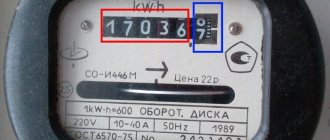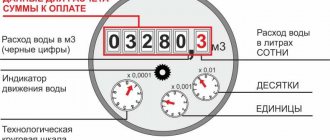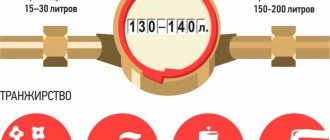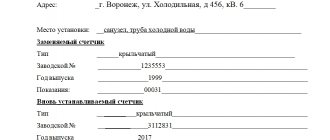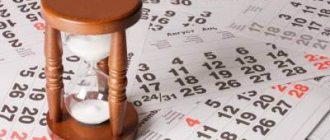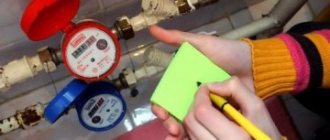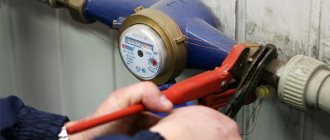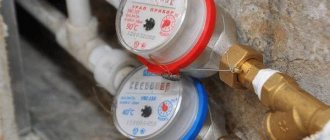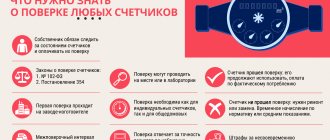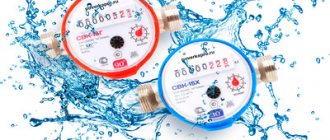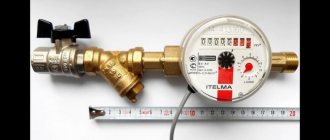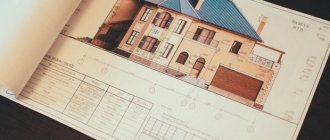Visual differences between hot and cold water meters
The widespread use of IPU (interpretation - individual metering devices) made it possible to establish control over resource consumption, which provided the opportunity for significant savings. Among the basic utilities that are metered, water supply is one of the most important. Depending on the design of the communication system of an apartment or house, the object may be equipped with one or two devices.
Water meters have visual differences that you need to pay attention to when purchasing and installing:
- Data on the box. The IPU of hot water is marked “DHW”, cold water – “HVS”. It is taken into account that the first option is universal and can be installed on any system, while the second is only suitable for a specific use.
- The color of the factory seal (edging) or lines on the body. Hot water meters are red, cold water meters are blue. This distinctive sign allows you to quickly and accurately determine the purpose of the device.
- Maximum temperature of the water passed through. Each mechanism has a list of technical characteristics on its main part, which includes the permitted temperature range. For cold water this is from +5 to +50°C (there are options up to +30 or +40°C), for hot water – up to +90.
There are several types of certified water meters, but all models designed for cold water metering have a blue or blue color, hot water meters are decorated with a red edging
Some modern devices do not have pronounced visual differences, so you should definitely look at the information in the passport.
On a note! It is recommended to pay attention to the date of verification of the meter: it is from this time that the countdown begins until the next performance assessment.
Payment methods for utilities
Today, technology is making our lives more and more easier, and we no longer need to stand in line for an hour to pay for utilities. Today there are a lot of payment methods, let’s look at the most optimal ones:
Payment via the Internet
One of the fastest and most convenient ways to pay bills, because you don’t even need to leave your home to do it. The most common payment method is through the personal account of Sberbank or the State Services portal. In the case of Sberbank, you can pay using a mobile phone or computer, and it is also possible to set the auto-payment function so that the payment takes place automatically.
Payment via terminal
Often in new houses you can find a terminal for paying for housing and communal services right at the entrance. But even if your home is not equipped with such a device, it can be found on almost every corner. This is convenient if you prefer to pay in cash. There are also bank terminals, for example, in the Sberbank terminal you can also easily pay a utility bill using the barcode of a receipt.
Payment at a payment acceptance point
In cities there are special payment offices where you can pay for housing and communal services in cash or with a bank card; you just need to come with a receipt. This method is good because you have a receipt in your hands - proof that the payment was made.
Taking readings
In order to correctly write off readings for submission to a service organization, you need to know exactly what to read.
The counter dial includes 8 digits. The first five black symbols are the main ones; they show the total number of cubic meters of water consumed. This information must be recorded on the payment receipt. The last three red digits are auxiliary, separated from the main ones by a comma and indicate the consumed liters.
At the moment, water meters are produced with three types of panels, but in the domestic sector, type No. 1 is considered the most popular and easiest to operate.
General rules for taking readings:
- The characters before the comma must be specified first. It is taken into account that when transmitting information there is no need to write off the leading zeros.
- If the last three digits are greater than 600, then it is advisable to round the value to the cube. This is not a violation.
Information from the meter should be taken according to the following scheme:
- The numbers on the dial (for example, 00015.784) indicate that more than 15 m3 of water was consumed during the corresponding period.
- The number of liters is rounded to 16 cubic meters. These readings are transferred for calculation.
- Next month the data will change and the dial will show 00022.184 (22 m3).
You need to understand that it is the current readings that are taken into account. But most often, the owner of the premises does not need to deal with the number of cubic meters; this is done by the service organization.
How to remove data correctly?
Water measuring devices are distinguished by the color of the device body:
- cold water – blue or black meter;
- hot water - meter in a red housing.
Each device can be marked with a marker: “X” and “G”. There will definitely not be any confusion.
On a kind of “display” under the glass of the water meter there is a scale with numbers - each of them in its own window. The numbers come first in black, followed by red .
The resource supplying organization is only interested in “black” numbers. They show how many cubic meters of water were used in a given apartment. Red data is current consumption in liters, it is not taken into account.
Correct reading consists of the following steps:
- Write down the first 5 digits from the counter.
- If there are more than 500 liters on the red part of the scale, add one to the last black number.
- Readings of the red part of the dial that do not reach 500 are simply discarded.
There are meters in which the scale shows the cubic capacity of the water, and the displacement is reflected on additional round dials. There are usually 4 such dials. The leftmost one shows data that is interesting only to a specialist - the technological flow of water. The other three are hundreds, tens and units of liters.
Readings from this type of device are taken in the same way: only 5 digits of the scale are taken . They are also rounded: if you used more than 500 liters, you need to add one to the last number; if you didn’t use them, you should not take into account the displacement.
Calculation example
Anyone living in a private house or apartment with water meters can independently calculate the expected payment amount for the billing period.
To do this, the following information is required:
- Indicators of cold water and hot water meters.
- Information from both counters for the past month. If there are no records, the data can be found on the receipt.
- Current tariff. It is individual for each subject of the Russian Federation. You can find out more information on special websites where the cost for the current period is published, or on the payment receipt.
You can calculate the monthly amount as follows:
- Take data from an individual hot water meter (conditionally 00085.456) and a cold water meter (000157.250).
- Prepare readings for the past period: DHW – 00080.255, cold water consumption – 000147.155.
- Find out the tariff for the region. It is taken into account that the cost is allowed to increase every year. Thus, in Moscow, from July 1, 2021, for most areas, one cube of cold water costs 35.40 rubles, hot water – 173.02 rubles.
- Determine the amount of resources consumed per month. To do this, the current values are subtracted from the previous ones (whole cubic meters are taken as a basis). For DHW: 85–80=5 m3, cold water: 157–147=10 m3.
- Calculate the payment amount:
DHW: 5m3 x 173.02=865.1 rub.
Cold water: 10m3 x 35.40=354 rub.
Total for the month: 865.1+354=1219.1 rub.
Water drainage calculations are made based on general data. Some service organizations post an online calculator on their websites; it can be used to calculate any resource provided, but only for informational purposes.
Attention! If the tariff in the payment document does not correspond to the one determined for a specific territory, then you must immediately contact the utility service provider. If your actions are illegal, you can file a complaint with the regulatory authorities.
Checking the correctness of the readings
Sometimes a situation may arise when the meter readings do not correspond to the real ones. You can verify how correctly the device works as follows. First you need to write down the meanings of the three red numbers. After this, you need to take a 10-liter bucket, pour water into it and pour it out. This must be done three times. Next you should look at the counter. If the water meter readings show that the amount of water used exceeds or falls short of 30 liters, then we can conclude that the device should be checked for correct operation .
How to fill out a receipt
At the moment, almost all accruals for consumed resources are carried out automatically. This provides a more convenient calculation procedure and eliminates errors, but does not relieve owners of houses and apartments from the need to check information.
In some situations, you may need to fill out the receipt yourself.
Sample of filling out a receipt
Step-by-step instruction:
- The period of document generation is indicated. All values must be entered legibly, without errors or corrections.
- Personal information is entered into the corresponding line of the table: full name, address, household IPU number, if it has not been registered previously.
- The number of people registered in the apartment or house and the number of persons entitled to receive benefits are indicated.
- If any, the debt or overpayment is included. The name of the service is marked taking into account the unit in which it is measured and the time period.
- The volume of consumption for the billing period is entered.
- Enter the full amount to be paid, after which you need to calculate the total taking into account benefits.
- All information is clarified and confirmed by signature.
- If during the specified period the meter was being calibrated, then consumption will be measured based on the average value for 3 or 6 months.
The completed receipt must be submitted to the institution that provides admission.
How to pay for water by meters
The procedure for making a payment may vary depending on the region and service company, but most often the standard scheme applies:
- Water meter readings are taken. Information must be submitted at a certain time. The exact period is not specified in the law and is set by housing and communal services enterprises and management companies independently. To avoid mistakes, it is better to clarify the period in the contract with the service provider. Information from the EIRC and other specialized organizations is accepted.
- Based on the data received, the service company makes a calculation and sends a receipt to the owner of the premises.
- Any authorized person can pay for the consumed resource. The easiest option is to give the document to a settlement center or bank.
It is taken into account that it is necessary to transmit water meter readings exclusively to the utility service provider. This role can be played by a homeowners’ association, a management company and supply organizations. Situations are also allowed when the main performer delegates the functions of receiving data to a specialized structure.
Service companies present different ways of taking testimony. The most convenient option is via the Internet or using programs. The traditional method is to enter the data on the form and leave it in a special box or take it directly to the organization’s office.
How are water charges calculated? Hot, cold, by meter and according to standards
11.03.2021
Water / Cold and hot water meters
Payment for water is one of the main items of utility costs for residents of apartment buildings. How is the payment amount calculated? And what is more profitable to pay - according to the meter or according to the standard? We will try to understand these issues based on existing practice and the current regulatory framework.
Water charges: where are the charging rules described?
The main document that describes various aspects of the topic that interests us is “Rules for the provision of utility services to owners and users of premises in apartment buildings and residential buildings,” approved by Decree of the Government of the Russian Federation of May 6, 2011 No. 354.
For simplicity, we will call them “Rules”. Link to the current version of the document - https://base.garant.ru/12186043/
Further, as we present the material, we will cite the paragraphs of the “Rules”, which spell out certain norms.
Calculation of water charges by meter
Residents of apartment buildings and private households (if they are connected to the central water supply system) can pay for water in two ways: based on meter readings, or according to standards.
By the way, this statement is by no means just a formality. Often homeowners are faced with an ultimatum from management companies or water utilities to install a water meter. They say that the mandatory installation of a water meter is a requirement of current legislation.
Now, that's not true. Clause 42 of the “Rules” states that in the absence of a water meter, the consumer has the right to pay for consumption based on the consumption standards in force in the given region.
But, let's return to the methods of calculating the amount of payments for water. With payment by meter, everything seems to be clear. In most cases, apartments are equipped with mechanical metering devices with a drum mechanism. Depending on the model, four or five black numbers to the left of the decimal point are visible in the slots. They mean whole cubic meters. The two or three red numbers to the right of the decimal point are tenths, hundredths and thousandths of a cubic meter. Write down the number and round to the nearest whole number. Subtract from it the previous readings taken a month ago. You will receive the water consumption in cubic meters.
If the apartment has several cold water meters (two or more), determine the flow rate for each of them, and add up the resulting numbers. The total consumption is calculated in the same way if there are several hot water meters.
The data is transmitted either to the building management company (HOA) or to the local water utility (if the apartment or private house has a direct water supply agreement).
In the received payment, the consumer sees his hot/cold water consumption in cubic meters, the current tariff for water supply and the amount to be paid.
Calculation of water charges according to the standard
The standard is an estimated consumption value, how much (theoretically) a person consumes water for domestic needs per month. Standards for water supply services are set in Russia by regional authorities, so they may differ markedly in different cities.
You can view the hot and cold water consumption standards in force in your locality on the website of the State Information System (GIS) of Housing and Communal Services in the section “Register of utility service consumption standards” - https://dom.gosuslugi.ru/#!/public-rate-consumption /list.
This information is also available on the website of the regional tariff regulatory authority (in different regions they have different names - committee on prices and tariffs, regional energy commission, etc.)
Finally, data on the size of consumption standards for hot/cold water supply and sanitation services are required to be provided to residents at their request by management companies (and HOAs) of apartment buildings.
The calculation according to the standard is made as follows: the number of people living in an apartment (private house) is multiplied by the water supply standard in force in a given region. The resulting volume of consumption is multiplied by the current tariff. The amount to be paid for the hot/cold water supply service is obtained.
According to the standard, water fees are charged in the following cases:
- The apartment (private house) is not equipped with a water consumption meter. And if the owner does not provide a certificate stating that it is not technically possible to install a meter, then an increasing standard of 1.5 is applied.
- The apartment (private house) is equipped with water meters, but its readings were not transmitted for more than three months in a row. In this case, the volume of water consumed is calculated according to the standard without an increasing factor.
- The apartment (private house) is equipped with water meters, but the meter is out of order (as an option, its verification period has expired). In this case, the volume of water consumption calculated according to the standard increases by a factor of 1.5.
Here it makes sense to make an important reservation: the water fee according to the standard is calculated based on the number of residents living in an apartment (private house) officially. Those. temporarily or permanently registered.
At the same time, the management organization of an apartment building has the right to check whether the actual number of residents corresponds to the number of officially registered ones? If in fact there are more people living in an apartment, then utility companies have the right to charge water fees based on the actual number of residents identified during the inspection.
If no one is officially registered in the apartment (private house), then water charges according to the standard are calculated based on the number of owners of the residential premises.
Payment for cold and hot water
With payments for cold water, everything is relatively simple. The volume of consumption is established, as mentioned above, either by meter or by standard. This figure is multiplied by the current tariff. The amount received is billed to the consumer for payment.
Tariffs for cold water can be found in the same place as consumption standards. Namely - on the websites of regional tariff authorities, GIS housing and communal services and in your management company. In addition, local water utilities also publish tariffs for the population.
The situation with calculating the payment for hot water is more complicated... Starting from 2012 (in different regions this happened in different years), residents began to be issued bills where they had to pay for the hot water supply service at the so-called “two-component” tariff. Water consumption is paid separately (RUB/cubic meter), and separately for the service of heating it (RUB/gigacalorie).
In this case, water consumption is determined by the readings of the hot water meter. Costs for heating water are calculated based on the corresponding standard - how much heat is needed to heat one cubic meter of water to the required temperature (from 60 to 75 C). This standard is not one for all occasions, but different for different types of houses. In this way, the individual characteristics of an apartment building are taken into account (presence/absence of heated towel rails, insulation of hot water supply risers, etc.). For more information about this, see paragraphs. 32 and 42 “Rules for the provision of public services”.
It is also worth noting that two-component tariffs for hot water have not yet been implemented in all regions. And even in those regions where in most houses residents pay a two-part tariff, in some high-rise buildings they charge the same as before - per cubic meter.
Formally speaking, the situation should come to a common denominator from January 1, 2021. It is by this date that current legislation requires regional authorities to approve heat consumption standards for heating hot water. And then it will be possible to apply two-component tariffs in all Russian regions.
But how this will work in practice is difficult to say. In fact, the final decision on the introduction of a two-component tariff for domestic hot water is made by the management organization (HOA or management company) of the apartment building.
Fee for sewerage service
The volume of sanitation services is calculated as the sum of cold and hot water consumption (fifth paragraph of clause 42 of the “Rules for the provision of utility services”). This service is paid at a rate approved by regional authorities.
If the apartment has both cold and hot water meters, then the volume of wastewater is equal to the sum of the readings of all water meters.
If there are no meters in the apartment, then the volume of wastewater is equal to the volume of cold and hot water consumed in the residential premises based on current standards. At the same time, the increasing factor of 1.5, which was discussed above, is not applied to determining the volume of sewerage services.
Finally, an important clarification - if at least one of the meters in an apartment fails (for example, it has expired), then the fee for the sewerage service is calculated according to the standards.
Water payment: recalculation for absence
An important question: is it possible to obtain a recalculation of water charges during a period when no one lives in the apartment (private house)?
The answer is this: this possibility exists only if the apartment (private house connected to a water supply system) is not equipped with water meters and the owner provides a document stating that it is not technically possible to install a meter.
In all other cases, during the absence of residents, you will have to pay for water either according to the meter (if it is installed and in good working order), or according to the standard (if there is no meter, or it is faulty, or the readings have not been transmitted) (clause 86 of the “Rules”).
According to the meter or according to the standard?
And in conclusion, the answer to a frequently asked question: what is more profitable to pay for water, by meter or by standard? It depends on how many people, on the one hand, actually live in the apartment and how many, on the other hand, are officially registered in the residential premises.
If two people live, but four are registered, then, of course, it is more profitable to pay by the meter. If, on the contrary, one person is registered, but five actually live, then the standard may turn out to be more profitable. Even taking into account the increasing factor of 1.5, if the apartment does not have meters or their verification period has expired.
If the meter is installed, it is in good working order and its service life has not expired, then you can switch to payment according to the standard simply without transmitting the meter readings. In this case, the increasing factor will not be applied.
However, it must be remembered that the management company (or water utility, if a direct water supply contract has been concluded) has the right to check the meter readings once every six months. And the owner is obliged to allow a representative of the management company or water utility into the residential premises so that he can check the condition of the meter and take readings. After this, the water fee will be recalculated based on the current meter readings and the currently valid tariff.
In addition, the management company has the right to check (with the involvement of representatives of local internal affairs bodies) the actual number of residents in the apartment (clause 32 e.1 of the “Rules”). And then charge fees according to the standard based on the identified real number of residents.
Recalculation of utility bills
In some situations, it may be necessary to verify the correctness of the enumeration.
If you overpay
Due to incorrect counter information or errors by the receiving employee, excess funds may appear in the account. According to RF PP No. 354, if discrepancies are detected, but provided that the IPU is fully operational and is not classified as out of order, the payment is recalculated.
To return funds, you must:
- Receive from the contractor a copy of the inspection report, which established the presence of surplus due to the difference in readings.
- Write a statement requesting a recalculation of the payment made.
- Submit the documents to a special department of the service company and be sure to receive confirmation that the information has been accepted for consideration.
If everything is done correctly, the due deduction will be indicated on the next receipt. If there is a significant overpayment, the amount is spread over several months.
Advice! If the contractor does not recalculate and does not provide an answer about the decision, you need to contact the regulatory authorities. The cause of failure may be a detected malfunction of the device or damage to control seals, which must be confirmed by an inspection report.
If testimony has not been submitted for a long time
The lack of information about consumed resources recorded by the IPU does not exempt the owner or tenant from paying, since residents are not limited in access to the service and can use water. Based on existing legislation (RF PP No. 354), each owner of a premises that is equipped with a meter has the right to calculate water consumption according to the readings of a correctly installed and commissioned meter. In such a situation, the amount is calculated at a single tariff for a specific region.
If you do not submit meter data, then the payment calculation method changes: for the first 3 months, the average indicator for the past six months is taken as a basis, and then according to the standard. Changing the situation is quite simple: you need to invite a specialist from a service organization to check the meter and take control readings.
In this case, it will not be possible to achieve recalculation, since it was the owner who ignored the right granted to him to submit monthly information.
Exceptions include special cases that may require legal proceedings where it will be necessary to prove the presence of force majeure circumstances or confirm temporary absence.
